Family name: Plantaginaceae Jussieu
Synonym(s): Antirrhinaceae Pers.; Aragoaceae D. Don; Callitrichaceae Link, nom. cons.; Chelonaceae Martinov; Digitalidaceae Martinov; Ellisiophyllaceae Honda; Globulariaceae DC., nom. cons.; Gratiolaceae Martinov; Hippuridaceae Vest, nom. cons.; Littorellaceae Gray; Psylliaceae Horan.; Sibthorpiaceae D. Don; Veronicaceae Cassel
Common name(s): plantain family
*Number of genera/species: 94/1,900
List of genera records in GRIN-Global
Fruit usually a capsulecapsule:
a dry, dehiscent fruit derived from a compound ovary (loculicidalloculicidal:
(loculicidalloculicidal:
type of capsular dehiscence, opening longitudinally through the locules (compare septicidal)
 and/or septicidalsepticidal:
and/or septicidalsepticidal:
type of capsular dehiscence, opening longitudinally by separating between the septa of adjacent carpels
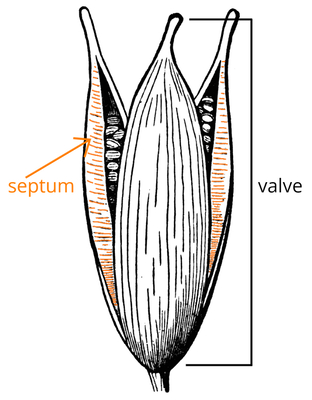 , circumcissile (Plantago), operculateoperculum:
, circumcissile (Plantago), operculateoperculum:
a dehiscent cap (or lid) of a seed or fruit that opens during germination or dehiscence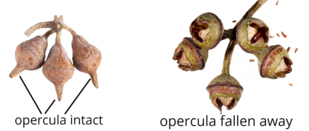 (Kickxia) or poricidalporicidal:
(Kickxia) or poricidalporicidal:
type of capsular dehiscence, fruit opening by pores or flaps (often near the top)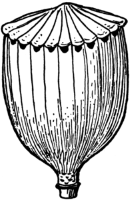 ), drupedrupe:
), drupedrupe:
(indehiscent drupe) a fleshy, indehiscent fruit with one more hard pits enclosing seeds, derived from single, superior, simple or compound ovary; (dehiscent drupe) a fruit with a dry or fibrous to fleshy or leathery outer husk that early to tardily breaks apart (or opens), exposing one or more nutlike pits enclosing the seeds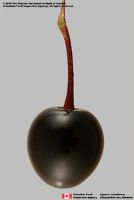 (Hippuris, Lagotis), nutletnutlet:
(Hippuris, Lagotis), nutletnutlet:
˜achene
(Littorella), or rarely berry-like (Hemiphragma spp), or schizocarpschizocarp:
usually dry fruit splitting between two or more locules to form distinct, indehiscent, usually one seeded segments; fruit derived from a single, superior or inferior, compound ovary; compare to mericarp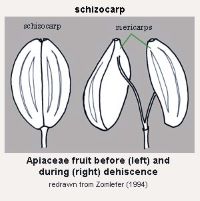 splitting into 4-drupe-like mericarpsmericarp:
splitting into 4-drupe-like mericarpsmericarp:
a one-seeded section (carpel) of a schizocarp, as in Apiaceae fruits (compare schizocarp)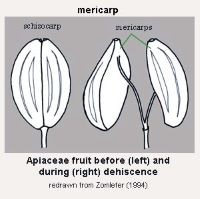 (Callitriche). Fruits usually 0.5–7 mm long, sometimes to 20 mm long (rarely to 70 mm long, Trapella), globoseglobose:
(Callitriche). Fruits usually 0.5–7 mm long, sometimes to 20 mm long (rarely to 70 mm long, Trapella), globoseglobose:
3D shape—more or less spherical , ellipsoidellipsoid:
, ellipsoidellipsoid:
3D shape—elliptic
, oblongoblong:
2D shape—much longer than broad with nearly parallel sides, corners are rounded , ovoidovoid:
, ovoidovoid:
3D shape—ovate , obcordiform, lanceoloidlanceoloid:
, obcordiform, lanceoloidlanceoloid:
3D shape—lanceolate
, trigonoustrigonous:
3D shape—having three faces that meet at distinct angles; triangular in outline
, deltoid-flabelliform, or reniformreniform:
2D or 3D shape—kidney-shaped (Veronica spp. or Callitriche mericarpsmericarp:
(Veronica spp. or Callitriche mericarpsmericarp:
a one-seeded section (carpel) of a schizocarp, as in Apiaceae fruits (compare schizocarp) ), tereteterete:
), tereteterete:
approximately circular in cross section; width and thickness approximately equal
 in transection, rarely angledangular:
in transection, rarely angledangular:
2D shape—having sides that meet at acute or obtuse angles
(Callitriche), stylestyle:
in a flower, the narrow and elongated part of the pistil between the stigma and the ovary; sometimes persisting in fruit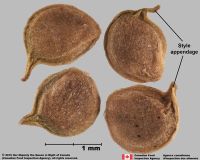 often persistent, with one seed (Hippuris, or 1-seeded mericarpsmericarp:
often persistent, with one seed (Hippuris, or 1-seeded mericarpsmericarp:
a one-seeded section (carpel) of a schizocarp, as in Apiaceae fruits (compare schizocarp) Callitriche), or with few to many seeds, sometimes calyxcalyx:
Callitriche), or with few to many seeds, sometimes calyxcalyx:
the outer whorl of the perianth; all the sepals of a flower persistent and accrescentaccrescent:
persistent and accrescentaccrescent:
growing continuously
. Pericarppericarp:
fruit wall or fruit coat
black, purple, brown, maroon, green, red (Hemiphragma, Lagotis spp.), or white, dulldull:
reflecting only a low proportion of incident light, with no apparent sheen , usually membranousmembranous:
, usually membranousmembranous:
texture—extremely thin, pliable, and fairly tough
, rarely fleshy or thick-walled, usually glabrousglabrous:
without hairs
, sometimes pubescentpubescent:
surface relief—bearing hairs
including with glandularglandular:
surface relief—covered with small, raised secretory glands, regular or irregularly shaped, translucent or opaque, and maybe distinctly colored hairs, smooth or keeledkeel:
hairs, smooth or keeledkeel:
a longitudinal ridge, like the keel of a boat, formed by the lengthwise folding of a structure, such as a lemma or palea
 , reticulatereticulate:
, reticulatereticulate:
surface relief—netted, raised walls or concave grooves forming a net-like surface pattern with flat, concave, or convex interspaces , groovedgrooved:
, groovedgrooved:
surface relief—linear depressions that may be single or form a series of grooves over the surface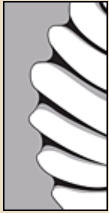 , veinedveined:
, veinedveined:
surface relief—lines that intersect in a vein pattern that is flush or slightly raised from the surface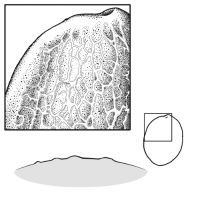 . Only Callitriche winged or at least keeledkeel:
. Only Callitriche winged or at least keeledkeel:
a longitudinal ridge, like the keel of a boat, formed by the lengthwise folding of a structure, such as a lemma or palea
 , if winged, 4 laterallateral:
, if winged, 4 laterallateral:
(of embryo) embryo lies along the side of the seed, generally towards one end; of, at, or from the side; in grasses, can refer to the sides adjacent to the dorsal and ventral sides
, straight or curled wings.
Seeds globoseglobose:
3D shape—more or less spherical to irregular, tereteterete:
to irregular, tereteterete:
approximately circular in cross section; width and thickness approximately equal
 , compressedcompressed:
, compressedcompressed:
flattened; in grasses, used to denote compression (not necessarily flattened) either laterally or dorsiventrally
, or flattened in transection, 0.1–5.5 mm long. Sometimes winged, if winged, 2 to 7 longitudinallongitudinal:
of or relating to length or the lengthwise dimension
wings or an emarginateemarginate:
with a shallow notch at apex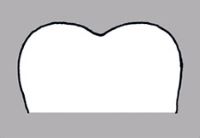 wing. Seed coat tight or loose, black, brown, gray, red, orange, yellow, or white, rarely spotted, dulldull:
wing. Seed coat tight or loose, black, brown, gray, red, orange, yellow, or white, rarely spotted, dulldull:
reflecting only a low proportion of incident light, with no apparent sheen or shinyshiny:
or shinyshiny:
uniformly reflecting a high proportion of incident light at all angles , seldom smooth, usually keeledkeel:
, seldom smooth, usually keeledkeel:
a longitudinal ridge, like the keel of a boat, formed by the lengthwise folding of a structure, such as a lemma or palea
 , groovedgrooved:
, groovedgrooved:
surface relief—linear depressions that may be single or form a series of grooves over the surface , ridgedridged:
, ridgedridged:
surface relief—raised, thick ridges, sharp edged or rounded, usually in a series that may cover the entire surface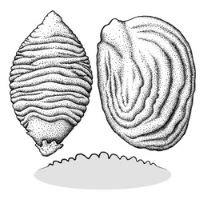 (longitudinally or transversetransverse:
(longitudinally or transversetransverse:
lying, situated, or placed across
, sometimes inrolled or irregular), striatestriate:
surface relief—having fine, parallel lines, grooves or ridges , pittedpitted:
, pittedpitted:
surface relief—surface with small depressions in which the areas between the hollows do not take on the appearance of a true reticular net , cristatecristate:
, cristatecristate:
with a crest
, reticulatereticulate:
surface relief—netted, raised walls or concave grooves forming a net-like surface pattern with flat, concave, or convex interspaces , papillatepapillate:
, papillatepapillate:
surface relief—bearing minute, distinct, broad-based projections, tapering to a rounded apex , wartywarty:
, wartywarty:
surface relief—distinct, rounded projections that are large relative to the fruit size; tuberculate, verrucose , or spinyspiny:
, or spinyspiny:
having slender, stiff, sharp projections oriented in the general plane of the structure . Seeds glabrousglabrous:
. Seeds glabrousglabrous:
without hairs
or pubescentpubescent:
surface relief—bearing hairs
. In Ellisiophyllum, viscid when wet. Hila usually at one end of seed and often very large and ornamented. In Plantago, hila marginal and ellipticelliptic:
2D shape—oval, oblong-like with the 2 ends narrowing and more or less alike
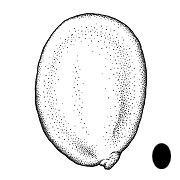 or oblongoblong:
or oblongoblong:
2D shape—much longer than broad with nearly parallel sides, corners are rounded .
.
Embryo well developed, axileaxile:
on or of the axis
and central (peripheralperipheral:
(of embryo) embryo is curved around the outer edge of the seed, near the seed coat
Plantago spp.), linearlinear:
(shape) long, narrow, and uniform in width; (of embryo) embryo is straight and much longer than wide or foliatefoliate:
or foliatefoliate:
appearing leaf-like
, straight, rarely curvedcurved:
(of embryo) linear embryo is curved into an arch or horseshoe with the ends far apart , parallel to seed length, except in Hippuris, transversetransverse:
, parallel to seed length, except in Hippuris, transversetransverse:
lying, situated, or placed across
to seed length. Cotyledons, thin, flat, entire at apexapex:
the point farthest from the point of attachment, or the "tip" of an organ (cleft, Hippuris), 0.1–0.6 times length of embryo.
(cleft, Hippuris), 0.1–0.6 times length of embryo.
Endosperm copious, thin (Callitriche, Gratioleae, Hippuris), or absent (Monttea), if present, smooth or ruminateruminate:
testa or seed coat folded into the endosperm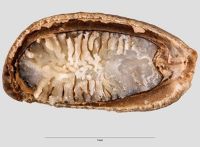 .
.
Several species of Plantago and Veronica are weedy in gardens, uplands, or fields and spread by seed reproduction. Specifically Veronica persica can act as a noxious weed in uplands, lawns, vegetables, and fields. It can be a host of harmful pathogens and insects, such as Cucumber mosaic virus, Plum pox virus, Aphanomyces cladogamus, and aphids.
Noxious Weed: USA Federal Noxious Weed List, aquatic, Limnophila sessiliflora (Vahl) Blume.
Federal Noxious Weed Disseminules of the US tool provides a description and images of this species. Aquarium & Pond Plants of the World tool also includes descriptions and images of this and other species in the family, which may be encountered.
| Fruit | |
| Type | capsulecapsule: a dry, dehiscent fruit derived from a compound ovary  , drupedrupe: , drupedrupe:(indehiscent drupe) a fleshy, indehiscent fruit with one more hard pits enclosing seeds, derived from single, superior, simple or compound ovary; (dehiscent drupe) a fruit with a dry or fibrous to fleshy or leathery outer husk that early to tardily breaks apart (or opens), exposing one or more nutlike pits enclosing the seeds  , nutletnutlet: , nutletnutlet:˜achene , berryberry: an indehiscent, fleshy fruit with one or a few to many seeds. The flesh may be homogenous throughout. Or, if the outer part is hard, firm, or leathery, referred to as an hesperidium. Septa are present in some, and the seeds may be arillate or with a fleshy testa. 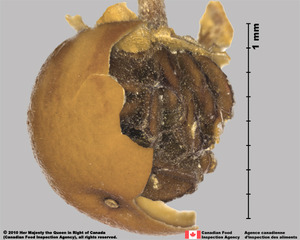 , schizocarpschizocarp: , schizocarpschizocarp:usually dry fruit splitting between two or more locules to form distinct, indehiscent, usually one seeded segments; fruit derived from a single, superior or inferior, compound ovary; compare to mericarp  splitting into 4-drupelike mericarpsmericarp: splitting into 4-drupelike mericarpsmericarp:a one-seeded section (carpel) of a schizocarp, as in Apiaceae fruits (compare schizocarp)  |
| Size range | 0.5–20 mm long, rarely to 70 mm (then includes three hooked appendages) |
| Shape(s) | globoseglobose: 3D shape—more or less spherical  , ellipsoidellipsoid: , ellipsoidellipsoid:3D shape—elliptic , oblongoblong: 2D shape—much longer than broad with nearly parallel sides, corners are rounded  , ovoidovoid: , ovoidovoid:3D shape—ovate  , obcordiform, lanceoloidlanceoloid: , obcordiform, lanceoloidlanceoloid:3D shape—lanceolate , trigonoustrigonous: 3D shape—having three faces that meet at distinct angles; triangular in outline , reniformreniform: 2D or 3D shape—kidney-shaped  deltoid-flabelliform deltoid-flabelliform |
| Texture | membranousmembranous: texture—extremely thin, pliable, and fairly tough , fleshy, thick-walled |
| Surface relief | smooth, keeledkeel: a longitudinal ridge, like the keel of a boat, formed by the lengthwise folding of a structure, such as a lemma or palea  , reticulatereticulate: , reticulatereticulate:surface relief—netted, raised walls or concave grooves forming a net-like surface pattern with flat, concave, or convex interspaces  , groovedgrooved: , groovedgrooved:surface relief—linear depressions that may be single or form a series of grooves over the surface  , veinedveined: , veinedveined:surface relief—lines that intersect in a vein pattern that is flush or slightly raised from the surface  |
| Color(s) | black, purple, brown, maroon, green, red, white |
| Unique features | Usually small, dulldull: reflecting only a low proportion of incident light, with no apparent sheen  , membranousmembranous: , membranousmembranous:texture—extremely thin, pliable, and fairly tough capsulescapsule: a dry, dehiscent fruit derived from a compound ovary  with numerous, usually minute to small, often reticulatereticulate: with numerous, usually minute to small, often reticulatereticulate:surface relief—netted, raised walls or concave grooves forming a net-like surface pattern with flat, concave, or convex interspaces  seeds. seeds. |
| Seed | |
| Size range | 0.1–5.5 mm long |
| Shape(s) | globoseglobose: 3D shape—more or less spherical  , hemisphericalhemispherical: , hemisphericalhemispherical:2D shape—shaped like half a sphere (cup-like), lens-shapedlens-shaped: 2D shape—round and flattened with two curved (convex) surfaces , ellipsoidellipsoid: 3D shape—elliptic , fusiformfusiform: spindle-shaped; broadest at the middle and tapering at both ends 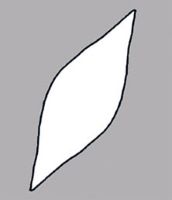 , oblongoblong: , oblongoblong:2D shape—much longer than broad with nearly parallel sides, corners are rounded  , ovoidovoid: , ovoidovoid:3D shape—ovate  , cylindriccylindrical: , cylindriccylindrical:3D shape—a cylinder, with parallel sides and a circular cross-section; tubular or rod-shaped , sectoroidsectoroid: 3D shape—a wedge-shaped slice taken from an ovoid or globose structure (2D shape, sector-shaped) 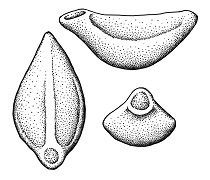 , angledangular: , angledangular:2D shape—having sides that meet at acute or obtuse angles , reniformreniform: 2D or 3D shape—kidney-shaped  , irregular , irregular |
| Surface relief | seldom smooth, usually keeledkeel: a longitudinal ridge, like the keel of a boat, formed by the lengthwise folding of a structure, such as a lemma or palea  , groovedgrooved: , groovedgrooved:surface relief—linear depressions that may be single or form a series of grooves over the surface  , ridgedridged: , ridgedridged:surface relief—raised, thick ridges, sharp edged or rounded, usually in a series that may cover the entire surface  (sometimes inrolled or irregular), striatestriate: (sometimes inrolled or irregular), striatestriate:surface relief—having fine, parallel lines, grooves or ridges  , pittedpitted: , pittedpitted:surface relief—surface with small depressions in which the areas between the hollows do not take on the appearance of a true reticular net  , cristatecristate: , cristatecristate:with a crest , reticulatereticulate: surface relief—netted, raised walls or concave grooves forming a net-like surface pattern with flat, concave, or convex interspaces  , papillatepapillate: , papillatepapillate:surface relief—bearing minute, distinct, broad-based projections, tapering to a rounded apex  , wartywarty: , wartywarty:surface relief—distinct, rounded projections that are large relative to the fruit size; tuberculate, verrucose  , spinyspiny: , spinyspiny:having slender, stiff, sharp projections oriented in the general plane of the structure  |
| Color(s) | black, brown, gray, red, orange, yellow, white, rarely spotted |
| Unique features | Minute to small seeds, often sculptured or ornamented, and with well-developed, usually straight embryo with thin, flat cotyledons. HilaHilum: on seeds, the scar indicating where the funiculus was attached; on grass caryopses, the scar visible on the outer fruit surface revealing where the seed is attached on the inner fruit wall surface; or in Asteraceae cypselae, the scar visible on the outer fruit wall revealing where the fruit was attached to the receptacle 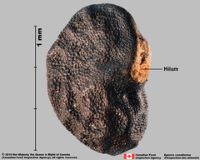 conspicuous and often very large and ornamented. conspicuous and often very large and ornamented. |
| Other | |
| Embryo | well developed, axileaxile: on or of the axis and central (peripheralperipheral: (of embryo) embryo is curved around the outer edge of the seed, near the seed coat Plantago spp.), linearlinear: (shape) long, narrow, and uniform in width; (of embryo) embryo is straight and much longer than wide  or foliatefoliate: or foliatefoliate:appearing leaf-like , straight, rarely curvedcurved: (of embryo) linear embryo is curved into an arch or horseshoe with the ends far apart  , parallel to seed length, except in Hippuris, transversetransverse: , parallel to seed length, except in Hippuris, transversetransverse:lying, situated, or placed across to seed length. Cotyledons, thin, flat, entire at apexapex: the point farthest from the point of attachment, or the "tip" of an organ  (cleft, Hippuris), 0.1–0.6 times length of embryo. (cleft, Hippuris), 0.1–0.6 times length of embryo. |
| Nutritive tissue | endosperm copious, thin (Callitriche, Gratioleae, Hippuris), or absent (Monttea), if present, smooth or ruminateruminate: testa or seed coat folded into the endosperm  |
Temperate regions.
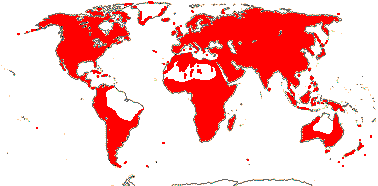
Distribution map courtesy of Angiosperm Phylogeny Website.
Barringer 1985Barringer 1985:
Barringer K. 1985. Revision of the genus Basistemon (Scrophulariaceae). Systematic Botany 10(2), 125&-133. https://doi.org/10.2307/2418338; Bean 2007Bean 2007:
Bean AR. 2007. A taxonomic revision of Callitriche L. (Callitrichaceae) in Australia. Austrobaileya 7(3), 545&-554. http://www.jstor.org/stable/41739055; Carlson 1957Carlson 1957:
Carlson MC. 1957. Monograph of the genus Russelia. Fieldiana Botany 29: 231&-292.; Flora of North America Editorial Committee 1993+Flora of North America Editorial Committee 1993+:
Flora of North America Editorial Committee, eds. 1993+. Flora of North America North of Mexico [Online]. 22+ vols. Flora of North America Association, New York and Oxford. Accessed January-March 2024. URL: http://beta.floranorthamerica.org.; Kirkbride et al. 2006Kirkbride et al. 2006:
Kirkbride JH, Jr, Gunn CR, and Dallwitz MJ. 2006. Family guide for fruits and seeds, vers. 1.0. Accessed September 2020-January 2022. URL: https://nt.ars-grin.gov/seedsfruits/keys/frsdfam/index.cfm .; Kubitzki et al. 1990+Kubitzki et al. 1990+:
Kubitzki K et al., eds. 1990+. The families and genera of vascular plants. 7+ vols. Berlin etc.; Mason 1959Mason 1959:
Mason R. 1959. Callitriche in New Zealand and Australia. Australian Journal of Botany 7.3: 295&-. Web.; Noxious Weed Regulations 2020Noxious Weed Regulations 2020:
Noxious Weed Regulations. 2020. 7 C.F.R. sect; 360.100-360.600.; Philcox 1970Philcox 1970:
Philcox D. 1970. A taxonomic revision of the genus Limnophila R.Br. (Scrophulariaceae). Kew Bulletin 24(1), 101&-iii. https://doi.org/10.2307/4103255; Takhtajan 2009Takhtajan 2009:
Takhtajan A. 2009. Flowering plants: Second edition. Springer Nature, Switzerland. 871 pp.; Turner and Cowan 1993Turner and Cowan 1993:
Turner B L and Cowan CC. 1993. Taxonomic overview of Stemodia (Scrophulariaceae) for North America and the West Indies. Phytologia 74: 61&-103.; USDA 1980USDA 1980:
United States Dept. of Agriculture (USDA). 1980. Major weed family identification guide. Hyattsville Md, United States ; Zhengyi et al. 2004+Zhengyi et al. 2004+:
Zhengyi W, Raven PH, and Deyuan H. 2004+. Flora of China [online]. 25 vols. Science Press, Beijing China & Missouri Botanical Garden, St. Louis USA. Accessed January–March 2024. http://flora.huh.harvard.edu/china/
*The number of genera and species is based on Christenhusz and Byng 2016Christenhusz and Byng 2016:
Christenhusz MJM and Byng JW. 2016. The number of known plant species in the world and its annual increase. Phytotaxa 261 (3): 201-217. https://doi.org/10.11646/phytotaxa.261.3.1, which may differ from the number of genera in GRIN-Global.